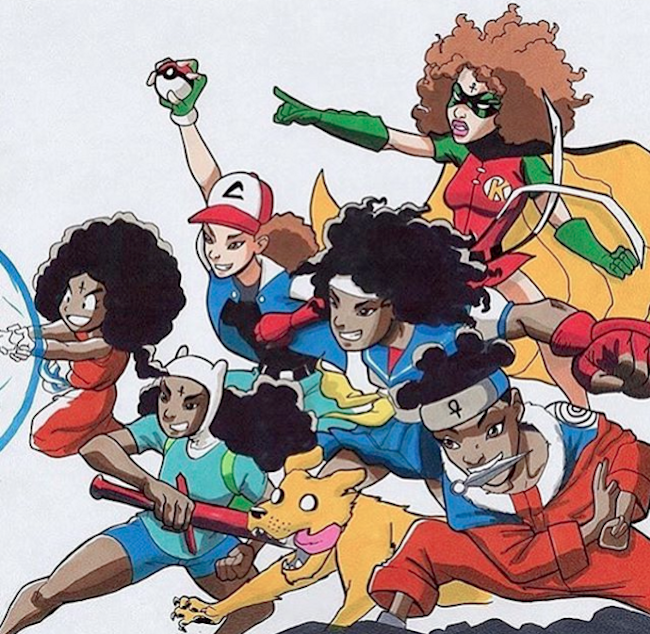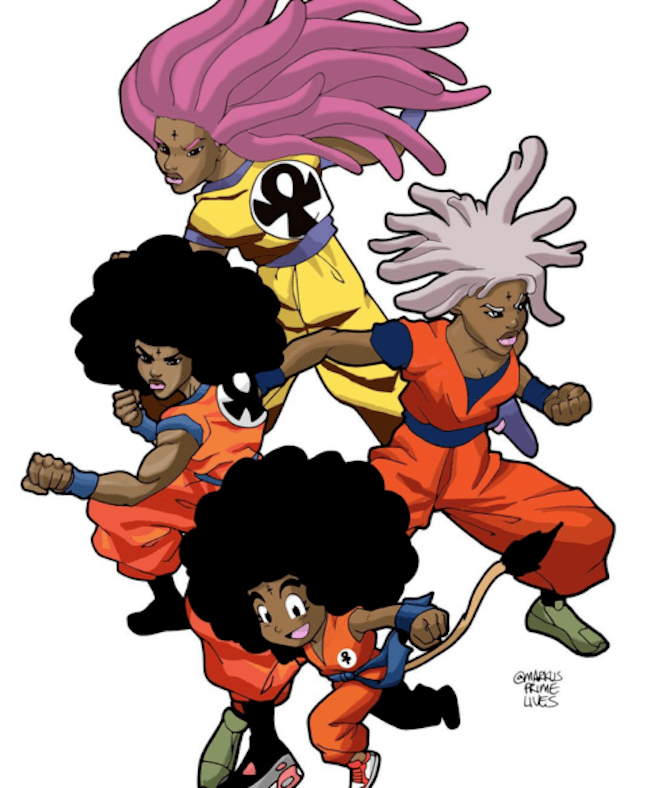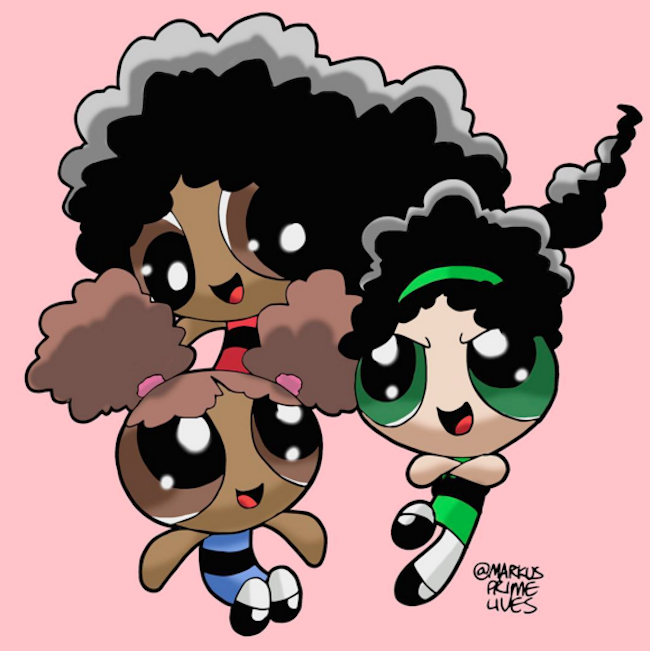One of the most memorable episodes of wonderfully weird cartoon series Adventure Time doesn’t feature the show’s duo Finn the Human and Jake the Dog at all — but gender-swapped versions of the lovable adventure-seekers, Fionna and Cake. The characters are the brainchildren of storyboard revisionist Natasha Allegri, who redesigned the duo as a “chubby cute” ass kicker and her magical cat in a series of webcomics before creator Pendleton Ward decided to feature her creations on the Cartoon Network series. The Fionna and Cake episode clocked 3.3 million viewers at the time of its airing in 2011 — then the most-watched installment of Adventure Time ever. The episode was beloved by critics and the characters became immensely popular with fans. So LA-based illustrator Markus Prime was surprised when his own new view on the character — Fionna as a young black woman — received online criticism.
Markus’ Fionna is one of many gender- and race-flipped cartoon characters that appear in his new sketchbook, B.R.U.H: Black Renditions of Universal Heroes. The project reimagines Pokemon trainers, Powerpuff Girls, and Dragon Ball Z slayers alike as young, empowered black women. The illustrator also got to work with real life superhero Amandla Stenberg, illustrating covers for her comic Niobe: She is Life. As B.R.U.H celebrates its release today, we catch up with Markus about inequality in the comic industry, intersections of art and activism, and why representation matters.

Which comics, anime, or graphic novels did you enjoy the most growing up?
The first comic I got into was definitely The Ninja Turtles, but Spiderman was the first one I really tried to draw. It taught me a lot about drawing dynamic poses and action scenes. Growing up, I got more into X-Men and a lot of Image Comics like Spawn and Wildcats. Then I started reading manga, so Dragon Ball Z was a favorite for sure.
When did you realize the marginalization of people of color within these graphic forms? Was it immediately apparent to you or something you learned as you interacted more with different styles?
I’ve always known, but I didn’t realize how big of an issue it is until I got older. Any child of color can tell when there’s one type of person, but growing up, I started to understand the importance of it. I think it began to bother me when I was in high school, and really bothered me when I came into the field and experienced it firsthand — to be in the industry and see people’s issues with it.

There have been some recent efforts on the part of massive comic book publishers to broaden representation — Miss Marvel comes to mind. But how do you see it from the inside? What needs to change?
What Marvel is doing is admirable and cool, but there still aren’t black people in control. They’re only gonna give up so much. I’ve gotten lots of comments on my book and illustrations where people have asked why I’m remaking white characters and not creating original ones. I definitely believe in that and it’s the plan, but what I’m doing with this project is showing them what it could have been, to get the conversation started. Also, it’s showing other people of color that if you’re the one behind it, it’ll reflect you better. The industry needs to hire more artists of color, it’s as simple as that. If they were allowing us to be in the industry illustrating or directing some of these movies, they’ll have whole other narratives because a black person is behind them. My book is trying to add to that resurgence of black creators and writers.
How did you select which characters to rework?
It was really natural because I’ve been doing it since middle school. Froku, the Dragon Ball Z character, was the first one. She kind of inspired the project because she became pretty popular online; people really responded to the set of changes I’d made for her. At first, I was thinking of doing a whole book only on Froku — Afro Ball Z — but I noticed that people were responding well to other characters I’d posted, too. People were freaking over the Powerpuff Girls and Adventure Time, for example.

Much of your other work focuses on themes of empowering women of color as well — like yourMcKinney, TX drawing. When and why did women become a focus for you?
Probably around four years ago. I was already heading in the direction of just trying to draw more people of color, then I started thinking that if I don’t see any black men, I definitely don’t see any black women. I don’t want to be the ambassador for black women — I can’t speak for them — but it was more about having the platform and wanting to change perceptions. It’s already difficult enough to be a woman in general in the industry, but now, we’re starting to see black women with their own booths at Comic Con. I just want to help change that narrative, to make it normal.
You did an alternate cover for Niobe: She is Life, which was illustrated by Ashley A. Woods. What was it like working with Amandla Stenberg on such an amazing project?
It’s been awesome. Amandla is a really amazing girl, wise beyond her years. Lots of people see her as this profound black power, but they forget she’s a 16-year-old girl, too. She brought it up and asked if I could be a part of it, and then to learn more about it and find out that a woman of color was doing all the illustrations, I had to be a part of it. Ashley Woods really taking the reigns on a project like this and still doing stuff for Marvel is amazing. Both of them were so inspiring to me. To see all these black girls at Comic Con excited about something that was for them was really, really cool.

How do art and activism collide for you?
Art and animation seem to have a profound influence on people because art blends into everything — music, fashion, and activism, for sure. I feel my work is an example of that. Sometimes you can draw a picture and really change things. To have a platform, be able to draw something so simple, and to have it affect so many people. That’s why I’m doing this, to encourage other artists of color because it shows the impact we do have.
What do you hope people take from this book, and from your work in general?
I want this book to be a contribution; this is my contribution to trying to make things better for our people. One day I’m gonna have a daughter or son and I want to tell them that I tried to do something to make it easier for them. This book would be a good little start. Hopefully it inspires people to create something they can identify with and believe in, too.
mlnnprime.com @markusprimelives
Credits
Text Emily Manning
Artwork Markus Prime
